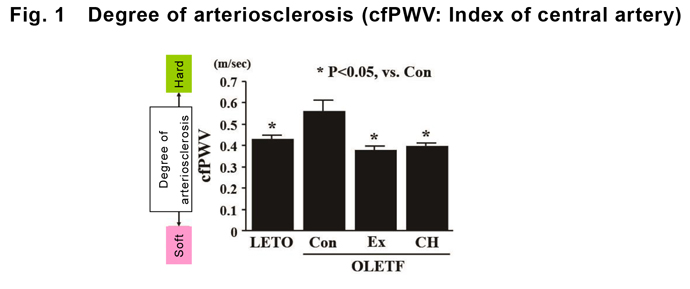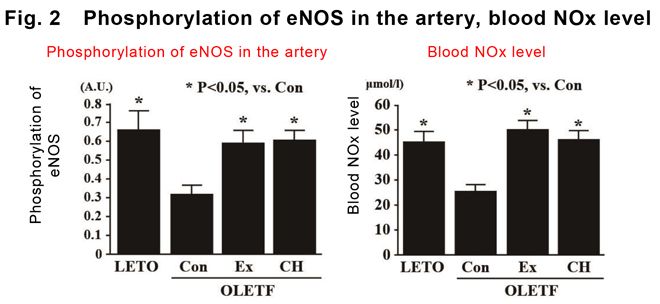- TOP
- List of reports
- Long-Term Chlorella Intake Decreases Degree of Arteriosclerosis in Type 2 Diabetic Rats
by Increasing Production of Endothelium-Derived Relaxing Substances
Long-Term Chlorella Intake Decreases Degree of Arteriosclerosis in Type 2 Diabetic Rats by Increasing Production of Endothelium-Derived Relaxing Substances
【Scientific information】
Research and Development Department, Sun Chlorella Corporation
Long-Term Chlorella Intake Decreases Degree of Arteriosclerosis
in Type 2 Diabetic Rats by Increasing Production of Endothelium-Derived
Relaxing Substances
Presented at the 71st Annual Meeting of Japan Society of Nutrition and Food Science
- Study objectives
- Type 2 diabetes mellitus is known to increase degree of arteriosclerosis by decreasing
vascular endothelial function.
In type 2 diabetic patients, habitual aerobic exercise decreases degree of arteriosclerosis by increasing the production of endothelium-derived relaxing substances (nitric oxide: NO). In recent years, long-term chlorella intake with antioxidant effects has been reported to decrease degree of arteriosclerosis in healthy middle or advanced, and young people. However, it is unknown whether long-term chlorella intake improves degree of arteriosclerosis in type 2 diabetic patients and the mechanism is also unclear. In this study, we examined whether long-term chlorella intake decreases degree of arteriosclerosis in type 2 diabetic rats with increasing degree of arteriosclerosis by increasing the production of endothelium-derived relaxing substances.
- Study method
- OLETF male rats (type 2 diabetic model rat) aged 20 weeks were divided into 4 groups,
7 rats in each group as follows, and the test was conducted.
As a healthy control group, we used LETO rats that were housed under resting
conditions for the same period.
[1] OLETF healthy control group (LETO group)
[2] Resting control group (OLETF-Con group)
[3] Chlorella intake group (OLETF-CH group)
[4] Aerobic training group (OLETF-Ex group)
OLETF-CH group received basic feed containing 0.5% chlorella powder for 8 weeks. OLETF-Ex group ran on a treadmill at 25 m/min for 60 minutes 5 days a week for 8 weeks.
As an index for degree of arteriosclerosis, carotid-femoral pulse wave velocity (cpPWV) was measured.
Also, phosphorylation of endothelial NO synthase (eNOS) in arterial tissue was measured with the Western blotting method and blood NOx (nitrite/nitrate) level was measured with the Griess method.
- Results
- Although cfPWV in OLETF-Con group significantly increased as compared with that in LETO group, cfPWV in OLETF-CH and OLETF-Ex groups significantly decreased as compared with that in OLETF-Con group (P<0.05). (Fig. 1) Also, phosphorylation of eNOS and blood NOx level in OLETF-Con group significantly decreased as compared with those in LETO group, whereas they significantly increased in OLETF-Ex and OLETF-CH groups. (Figs. 2 and 3)
- The above results suggested that as with an aerobic training, long-term chlorella intake could have effects of decreasing degree of arteriosclerosis in type 2 diabetic rats by increasing the production of endothelium-derived relaxing substances.


Details
- Academic society:
- The 71st Annual Meeting of Japan Society of Nutrition and Food Science
- Title:
- Long-Term Chlorella Intake Decreases Degree of Arteriosclerosis in Type 2 Diabetic Rats by Increasing Production of Endothelium-Derived Relaxing Substances
- Authors:
- Shumpei Fujie1),2),Natsuki Hasegawa1),2), Naoki Horii1),Toru Mizoguchi3),Masato Onishi3),Masataka Uchida1),Motoyuki Iemitsu1)
- Affiliation:
- 1) Ritsumeikan University Graduate School of Sport and Health Science
2) Research Fellowship for Young Scientists (DC) of Japan Society for the Promotion of Science
3) Sun Chlorella Corporation





